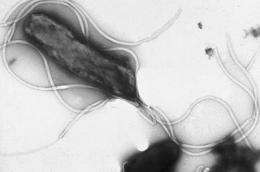Cancer-causing bacterium targets tumor-suppressor protein

Researchers have discovered a mechanism by which Helicobacter pylori, the only known cancer-causing bacterium, disables a tumor suppressor protein in host cells.
The new study, in the journal Oncogene, reports the discovery of a previously unknown mechanism linking H. pylori infection and stomach cancer, the second leading cause of cancer deaths worldwide.
About two-thirds of the world's population is infected with H. pylori, a bacterium that can survive in the harsh environment of the stomach. Most infected people never develop disease. For a significant minority, however, infection with H. pylori leads to inflammation, ulcers and in some cases, stomach (gastric) cancer.
H. pylori's ability to cause disease is closely associated with a virulence protein called CagA. Previous studies have found that CagA-positive strains are much more likely to cause inflammation and spur the abnormal cell division and growth of cells that lead to cancer.
H. pylori injects CagA into the epithelial cells that line the stomach. Within the cells, CagA is able to hijack various signaling pathways and disrupt proper cellular functions.
Other studies have identified RUNX3 (pronounced RUNKS-three) as an important gastric cancer tumor suppressor.
Loss of expression of RUNX3 is causally associated with the development of gastric cancer, said University of Illinois medical biochemistry professor Lin-Feng Chen, who led the study. RUNX3 guards against tumor formation by spurring the production of factors that target unhealthy cells for destruction.
"Although emerging evidence suggests that RUNX3 is a tumor suppressor whose inactivation is involved in the initiation and progression of gastric cancer," the authors wrote, "the trigger for RUNX3 inactivation within gastric cells is largely unknown."
"The protein, RUNX3, is a transcription factor, so it activates different kinds of genes controlling cell growth and death," Chen said. "The first thing we wanted to see was whether H. pylori has any effect on the transcription activity of RUNX3."
Two graduate students in Chen's lab, Ying-Hung Nicole Tsang and Acacia Lamb, began the study by examining RUNX3 transcription activity in H. pylori-infected gastric epithelial cells. They found that infection with CagA-positive H. pylori inhibited the transcription activity of RUNX3 and reduced levels of the RUNX3 protein in cells.
CagA-negative H. pylori had no effect on RUNX3 levels or activity.
"In fact, CagA alone is sufficient to down-regulate the RUNX3 transcription activity and reduce the expression of RUNX3, further supporting the importance of this bacterial protein in the genesis of gastric disease," Chen said.
Further tests revealed that CagA and RUNX3 physically interact with each other in human epithelial cells. The researchers found that a newly identified domain within CagA, the WW domain, recognizes a sequence in the RUNX3 protein known as the "PY motif." They further showed that this interaction leads to the "tagging" of RUNX3 for degradation via a process called ubiquitination.
Previous studies found that there are several unique sequences within the
carboxyl-terminal region of CagA that are vital to the protein's ability to interact with host proteins and disrupt normal cellular processes.
"This is the first time anybody has identified a unique domain within the
amino-terminal region of the CagA protein, and it will help us to better understand how this oncogenic protein functions," Chen said. "This study has uncovered a new step in the initiation of H. pylori-induced gastric cancer."
The accumulation of many deleterious changes in cells leads to the development of cancer. RUNX3 helps cells react when cellular processes go awry, so H. pylori-induced degradation of RUNX3 "could produce conditions in which aberrant cellular changes are less inhibited," Chen said.
Chen's group is working to identify the molecular mechanism by which CagA targets RUNX3 for degradation. He and his colleagues hope to design small molecules that can specifically inhibit the interaction between RUNX3 and CagA and block the degradation of RUNX3. Such drugs may be used to prevent the gastric diseases induced by H. pylori.














